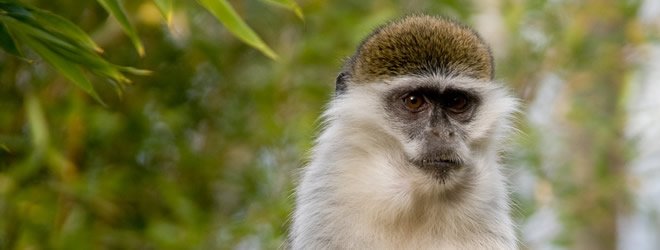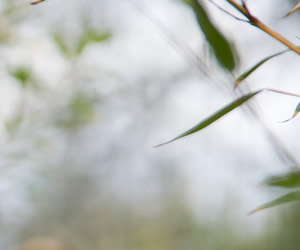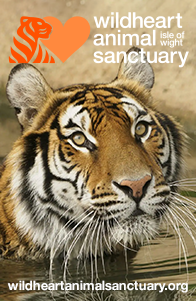Autumn at the Isle of Wight Zoo
October 24, 2016By Charlotte Corney, Zoo Director, Isle of Wight Zoo
So the sweet smell of summer is suddenly a distant memory as exhausted leaves rain down on us and we wave an annual goodbye to our migratory birds. Meanwhile, pumpkin faces loom into view and mountains of mince pies are already on the horizon. There’s no mistaking the arrival of autumn, the season which has the habit of being rudely punctual, and we all feel a little robbed of our time in the sun.
A special island
This year I did fulfil a pledge to make use of the fact that ‘home’ is on a microclimatic Island jewel surrounded by sparkling seas and this resulted in a few, surprisingly warm, ocean dips. The Isle of Wight really is a special place and it’s a pleasure to share it with over 2.5 million visitors every year. Like so many local organisations, we are dependant on a healthy summer season to support us through the winter months. Thankfully we did have a successful few months of footfall and we couldn’t even complain about the weather – it was perfect.
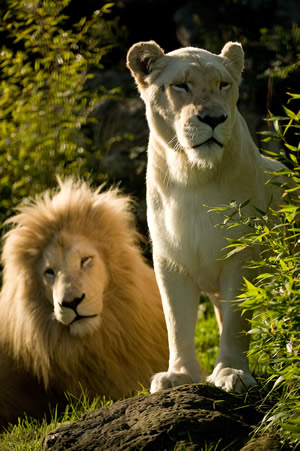
Casper and Frosty enjoying each others’ company
Playful & affectionate
Since my last blog the zoo has been a hive of activity. Back in the spring we fully integrated our male and female white lions, Casper and Frosty, after a lengthy period of socialization while sharing a split enclosure. The pair are half brother and sister and as we don’t want them to breed (we adhere to an EU directive not to breed white lions or tigers due to health issues resulting from inbreeding) we spayed Frosty.
After a tense introduction the siblings have grown very accustomed to each others’ company and are gradually becoming more playful and affectionate. Our volunteers have been their guardian angels, patiently watching over them for many weeks.
Posturing females
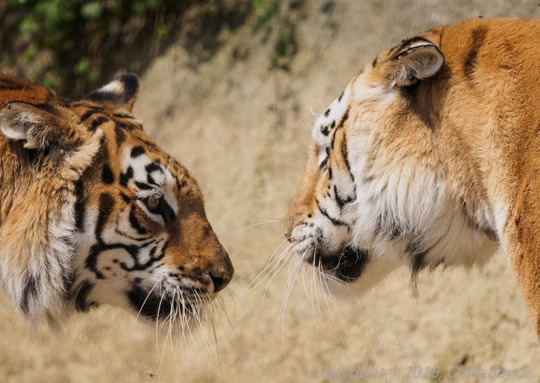
Aysha and Zia are integrated for the first time
Another blossoming feline friendship has been between female tigers, Aysha (who lost her brother to kidney disease in 2015) and Zia. We debated the ethical reasoning for attempting to put the two girls together and decided our motivation was sound: the potential benefit for Aysha to have tiger company once again. Having grown up for many years next-door to each other in another area of the zoo they were familiar with each other and this showed when they were re-united via a new tunnel system linking their current accommodation. They chuffed and head-rubbed with no animosity but I confess I hardly slept the night before putting their relationship to the test. I hand-reared both tigers in the mid to late 1990’s and they’re both very close to my heart.
Anyway, after a bit of shouting (the tigers not us!) and posturing the girls soon relaxed and were doing what cats do best – sleeping!
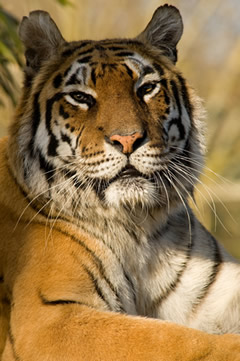
Simi is settling in to her new home
Simi update
Nine months on and Simi the ex-circus tiger who came to live with us in the new year, now looks like she’s had a make-over! Her condition has much improved but she’s still somewhat wobbly when walking so we’re planning to take her on a road trip across the water to have an MRI scan, we’re busy building a custom made travel crate ready for the journey.
Just before the summer we heard the news that the tiger, Darco, who’d made friends with Simi at the temporary rescue centre in Belgium, had passed away. I’ll never forget his face when we moved Simi out under the still starry morning sky, I’d promised we’d be back for him but it was not to be. He was an old boy but at least he’d tasted what it felt like to be loved after existing in a condemned Croatian zoo for most of his life.
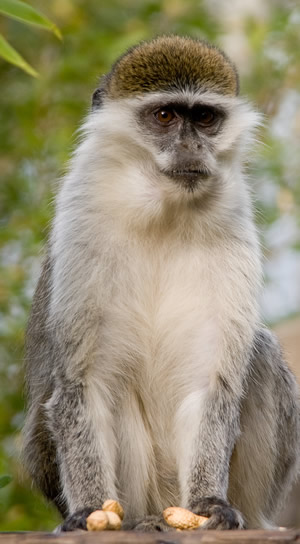
One of our inquisitive vervet monkeys
Simi’s new neighbours – Vervet monkeys
A trio of vervet monkeys have recently moved into a renovated habitat opposite Simi. Sebastian, Hercules and Africa are the descendants of a once much larger group of these monkeys which bred at the zoo.
I encountered a few members of this species in The Gambia earlier this year, hanging around the hotel gardens they were considered pests by the staff. Despite warnings not to feed them the guests would and needless to say this sometimes ended in tears when they got a bit cocky. Retrospectively, I’ve got fond memories of being woken early to the sound of a herd of elephants stampeding over the corrugated roofing of the bedroom – which was, in fact, the vervets playing tag.
It seems they’re enchanting to watch whether you happen to be in their country or they’re in yours; I love to observe the soap opera-like relationships between our group.
As you no doubt are aware, one of London Zoo’s rather larger African primates, ‘Kumbuka’ the lowland silverback gorilla, found himself at the centre of a media circus recently after he took a detour from his living quarters ending up in a staff service zone. After downing five litres of blackcurrent juice, Kumbuka strolled back to his bedroom with his human carer/pal; surely he’s now the hot new face of Ribena? Animal ‘escapes’ in zoos always attract a disproportionate amount of news coverage the moment that social media breaks out in it’s often ill-informed rash. Personally, I feel that the zoo team managed the situation in an exemplary way and director David Field blogged about it with transparency here: www.zsl.org/blogs/kumbuka-the-gorilla-what-actually-happened
‘For the Love of Lemurs’ Challenge
In a few days time I’ll be heading up to London Zoo with two other members of staff, Lisa and Abbie. We’re doing something which every cell in our bodies is telling us not to do – we’re going ‘In With The Spiders’ (the zoo’s new spider walkthrough area)! We’ve been challenged to face our arachnophobia as part of our ‘For the Love of Lemurs’ week where we invite staff, and anyone else who want to participate, to leave their comfort zone to raise funds and awareness for the conservation of these endangered Madagascan primates; our event ties into the World Lemur Festival www.accessinitiative.org/blog/world-lemur-festival-2016-third-edition We support an agro-forestry project in eastern Madagascar as we are members of the Madagascar Fauna and Flora Group www.madagascarfaunaflora.org.

Education & Conservation Officer Tracy Dove proving her love for lemurs!
Our Education and Conservation Officer, Tracy, is hopefully having a bath and/or a glass of champagne as I type having just run 10 miles in the Great South Run which was her energetic contribution! Tracy has been to Madagascar to help the MFG with their work and attended their annual conference in Taiwan this year. She’s determined that we throw lemurs a lifeline, if you’d like to help then please leap onto this link: www.gofundme.com/2tkqxdzu
While lemurs are hunted by humans as a food source, their main threat is habitat degradation. African lions are also, of course, plagued by the effects of loss of suitable living space but they’re also persecuted by trophy hunters (as the world came to realise via the killing of ‘Cecil’ in Zimbabwe last year) and have their bones, teeth and claws traded for east Asian medicine use. A few weeks ago, at the global wildlife summit in Johannesburg, CITES opted to compromise on legislating against a total ban in the commercial trade of this once common predator which now occupies just 8% of its former range and numbers less than 20,000 wild individuals.
Despite our disappointment it must be said that progress, however small, should be acknowledged and for that reason we were pleased to hear that it will become illegal to trade in wild lion derivatives. But, and there’s always a ‘but’ , it will still be legal for captive lions to be traded into the medicine market. Between 2008-2011 South Africa alone exported over 1,200 skeletons.
The concern is that the adopted grey, rather than black and white, status will make law enforcement much harder – proving provenance will not be easy and will undoubtedly provide loopholes for the killing of wild lions.
Really Wild Photography Workshops
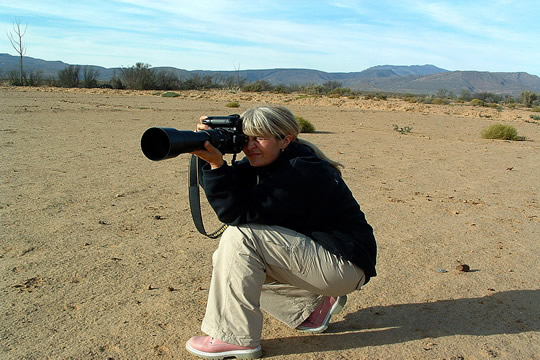
The zoo hosts ‘Really Wild Photography’ workshops
Here at the IOW Zoo we often enjoy shooting our animals but with cameras not guns! Every year our resident professional photographer, Karen, hosts a series of popular workshops. Karen’s approach is to “take nothing from nature, apart from the photo to preserve the vision of its beauty”. Let’s hope progress will prevail and one day eco-tourism will wipe the consumerist trade in wildlife clean away.
You can see what we offer in the way of photographic clubs and workshops here: www.isleofwightzoo.com/products/really-wild-photography (and with jingle bells in the distance, a ‘Really Wild Photography Workshop’ could help cross one off the present list!).
Big Cat Training workshops
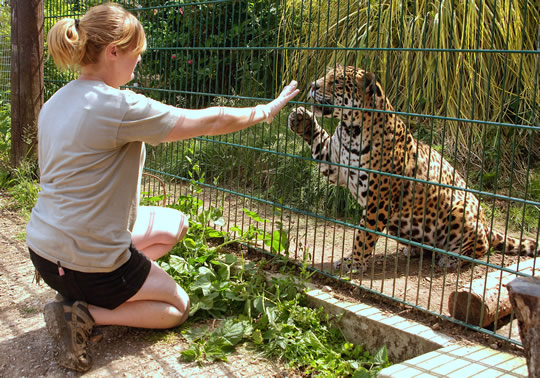
Big Cat Training workshops are a special treat for animal lovers
Just as we don’t shoot our animals, nor do we train them for human entertainment. We do, however, incorporate operant conditioning into our health care and enrichment programmes to help us gain the trust and cooperation of our animal friends, which is particularly important when they have big teeth and claws! Sometimes the latter need clipping to prevent them over-growing into the paw pads. Zena our elderly white tiger recently had a stress-free pedicure when her carers, Carolyn and Kim, noticed her claws were getting long. They’d taught Zena to tolerate the procedure without the need for anaesthetic and their time investment paid dividends. At the beginning of October they presented their techniques at a Big Cat Training workshop we hosted for the zoo community to share good practice in this field.
If you have a big cat lover in your life who would like to learn about and participate in our training experience you can find out more here: www.isleofwightzoo.com/products/animal-experiences/big-cat-training-experience
Well, that turned out to be a bumper blog!
If you made it through to the end, well done and thanks for staying with me! If you fancy a trip over to the zoo it would be great to see you in person and welcome you to our ‘zoo on the beach’. We’re open all year round (except Christmas day), with reduced daily opening hours from November to February.
You can get good joint ferry/hovercraft and zoo admission packages here:
www.redfunnel.co.uk/island-guide/isle-of-wight-zoo-tickets
www.wightlink.co.uk/top-attractions/isle-of-wight-zoo
www.hovertravel.co.uk/attractions/iow-zoo
Charlotte Corney
Director
Isle of Wight Zoo

